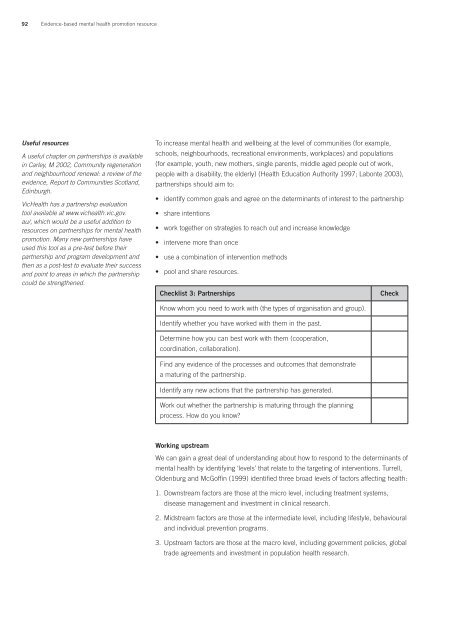Evidence-based mental health promotion resource - health.vic.gov.au
Evidence-based mental health promotion resource - health.vic.gov.au
Evidence-based mental health promotion resource - health.vic.gov.au
Create successful ePaper yourself
Turn your PDF publications into a flip-book with our unique Google optimized e-Paper software.
92 <strong>Evidence</strong>-<strong>based</strong> <strong>mental</strong> <strong>health</strong> <strong>promotion</strong> <strong>resource</strong>Useful <strong>resource</strong>sA useful chapter on partnerships is availablein Carley, M 2002, Community regenerationand neighbourhood renewal: a review of theevidence, Report to Communities Scotland,Edinburgh.VicHealth has a partnership evaluationtool available at www.<strong>vic</strong><strong>health</strong>.<strong>vic</strong>.<strong>gov</strong>.<strong>au</strong>/, which would be a useful addition to<strong>resource</strong>s on partnerships for <strong>mental</strong> <strong>health</strong><strong>promotion</strong>. Many new partnerships haveused this tool as a pre-test before theirpartnership and program development andthen as a post-test to evaluate their successand point to areas in which the partnershipcould be strengthened.To increase <strong>mental</strong> <strong>health</strong> and wellbeing at the level of communities (for example,schools, neighbourhoods, recreational environments, workplaces) and populations(for example, youth, new mothers, single parents, middle aged people out of work,people with a disability, the elderly) (Health Education Authority 1997; Labonte 2003),partnerships should aim to:• identify common goals and agree on the determinants of interest to the partnership• share intentions• work together on strategies to reach out and increase knowledge• intervene more than once• use a combination of intervention methods• pool and share <strong>resource</strong>s.Checklist 3: PartnershipsCheckKnow whom you need to work with (the types of organisation and group).Identify whether you have worked with them in the past.Determine how you can best work with them (cooperation,coordination, collaboration).Find any evidence of the processes and outcomes that demonstratea maturing of the partnership.Identify any new actions that the partnership has generated.Work out whether the partnership is maturing through the planningprocess. How do you know?Working upstreamWe can gain a great deal of understanding about how to respond to the determinants of<strong>mental</strong> <strong>health</strong> by identifying ‘levels’ that relate to the targeting of interventions. Turrell,Oldenburg and McGoffin (1999) identified three broad levels of factors affecting <strong>health</strong>:1. Downstream factors are those at the micro level, including treatment systems,disease management and investment in clinical research.2. Midstream factors are those at the intermediate level, including lifestyle, behaviouraland individual prevention programs.3. Upstream factors are those at the macro level, including <strong>gov</strong>ernment policies, globaltrade agreements and investment in population <strong>health</strong> research.



